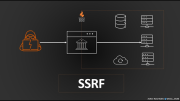
Web applications play a crucial role in our digitized era. We rely on web-based tools for our everyday needs, such as online shopping, booking deliveries, making or receiving payment transactions, and posting on social media platforms. Hence, the increased usage of these web applications calls for heightened concern about security risks and data breaches.
Statistics show that between 2021 and 2022, there were 300 cases of data breaches in the public administration industry, 213 data breaches in the financial sector, and 110 cases of data breaches in the utilities and mining sector.
One major web application vulnerability is Server-Side Request Forgery (SSRF) attacks, which threaten the safety and reliability of web applications.
In this article, we will explore SSRF attacks in detail: how they work, real-world examples of server-side request forgery, and tips to protect your web applications against this vulnerability.
What is Server Side Request Forgery (SSRF)?
Server-side request forgery (SSRF)is a web development vulnerability that enables attackers to make the server-side application send requests to unintended locations. It’s a kind of attack that allows a hacker to make requests from a server to different places. Sometimes, hackers use this to move around networks, access internal systems, or get sensitive info from certain points. The seriousness of this attack can vary depending on things like how much info they get back and how important the stuff they access is.
If an SSRF attack is successful, it could lead to unauthorized entry into confidential data, potentially causing a breach. Yet, the seriousness of such a breach hinges on factors like the kind of data retrieved, existing security measures, and the attacker’s intentions. Thus, while SSRF attacks carry the risk of data breaches, the actual outcome depends on the unique circumstances of each attack.
In a common SSRF attack, the attacker could make the server establish a connection to internal services that are only accessible within the organization’s infrastructure. Alternatively, they might compel the server to connect to any external systems of their choice. This could result in disclosing sensitive information, such as authorization credentials.
How do SSRF attacks work?
SSRF, short for Server-Side Request Forgery, exploits weaknesses in web applications to control server-side functions. Here’s a simplified explanation of how they usually operate:
SSRF exploits input fields
Attackers misuse fields in a web application where users can input a URL from which the server can retrieve data. These fields could be found in functionalities like uploading images or files, previewing websites, or making API requests.
It creates harmful requests.
The attacker forms a harmful request by entering a URL directing to a resource or server under their control, or to a limited internal network resource.
SSRF can gain access to confidential information or resources
Depending on the attacker’s objectives, they can use SSRF to reach sensitive data or resources within the internal network that are not meant to be accessible from the public internet. This might involve reaching confidential databases, internal APIs, or other systems.
SSRF submits unauthorized requests
Once the server handles the request, it sends a request to the URL provided by the attacker, presuming it’s valid. However, as the attacker manages the URL, they can instruct the server to access unauthorized resources or carry out actions on internal systems.
It extends their access to internal network and systems
In advanced SSRF attacks, perpetrators can utilize the compromised server to extend their access into the internal network, increase privileges, or initiate additional attacks, like moving laterally within the network or targeting other internal systems.
SSRF attacks take advantage of the server’s trust by manipulating it to make unexpected requests, which could result in unauthorized access to sensitive data, compromise of the network, or further exploitation of the web development platforms and internal systems.
Real-world Examples of SSRF attacks
To understand SSRF attacks better, here are two real-world examples of SSRF attacks:
● Yahoo
In 2014, Yahoo experienced an incident involving an SSRF attack on its advertising platform. The attacker took advantage of a weakness in Yahoo’s image processing library to compel the server to make requests to internal Yahoo services. By manipulating these requests, the attacker accessed sensitive information, including Yahoo’s private key for generating authentication tokens. This security breach compromised the safety of millions of Yahoo users and led to a substantial data breach.
● Adobe Systems
In 2010, Adobe Systems encountered an incident involving an SSRF attack. During this event, a perpetrator took advantage of a weakness in the Adobe Connect service. By manipulating the application, the attacker made requests to internal resources within Adobe’s network, accessing services that were not meant to be reachable from external sources. This enabled the attacker to obtain sensitive data and potentially compromise other systems within Adobe’s infrastructure.
These examples show how attackers use SSRF attacks to exploit weaknesses in web applications, gaining unauthorized access to internal resources and sensitive data.

7 Ways to Protect Your Web Apps from Vulnerabilities
1. Regular security audits and testing
2. Keeping software and libraries up to date
3. Educating developers and users about SSRF risks
4. Implementing monitoring and alerting systems
5. Enforcing proper authentication and authorization
6. Utilizing network firewalls and restricting outgoing connections
7. Partnering with reliable web application testing services for quality assurance and regular performance and security testing
Conclusion
The pervasive use of web applications in various sectors has brought heightened concerns about security risks and data breaches. Real-world examples, such as those encountered by Yahoo and Adobe Systems, illustrate how SSRF attacks exploit vulnerabilities in web applications, leading to unauthorized access to internal resources and sensitive data. To mitigate these risks, implementing proactive measures such as regular security audits, software updates, user education, monitoring systems, authentication enforcement, firewall usage, and collaborating with web application testing services are crucial steps in safeguarding web applications against vulnerabilities.
